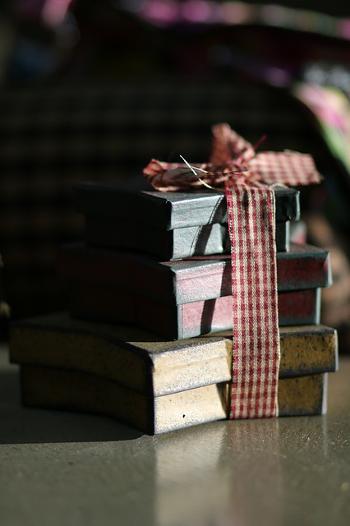Wrapping it up
Duration/age

You have found the perfect present for that special person and now it is time to wrap it up. You can ask your child to help you.
Start by talking about the size of the present and the amount of paper you will need to cover it up. Is the present a regular shape like a box with straight sides? Or is it an irregular shape that is a mixture of curved and straight sides?
We have bought Baba shoes for his birthday. They come in a box so it will be easy to wrap.
Skye is getting a football for her birthday. There are no straight sides. That is going to be tricky to wrap.
Before you start to wrap the present talk to your child about how much paper you will need to wrap the present. How will you figure it out? Will you need to measure the paper first?
Let’s roll out some of the paper and put the ball on top. We can fold the sides of the paper over the top of the ball to see how much paper we need.
The book is very wide but not very long. We’ll need to cut the paper in half.
When you have worked out the amount of paper you will need you can start wrapping. Talk about where you will put the present and how to start.
Let’s put the box in the middle of the paper and fold the sides onto the top of the box first.
Materials you will need
- Scissors
- Ribbon
- Tape
- Present
- Wrapping paper
Alternative tools
- Paper
- Newspaper
- String
- Your child's painting
Skills this activity improves
Why does this matter?
When your child helps you to wrap a present they are learning about measurement, spatial awareness and the different ways we can compare size. Size can be compared using volume, capacity, mass, time and temperature.
As you talk to your child they will hear the different language of size and measurement. The words that you use will help your child to follow directions and to predict what will happen.
What does this lead to?
Exploring the different ways we can measure objects encourages children to problem-solve and to notice similarities and differences. When children can identify what is the same about an object they begin to generalise solutions and strategies from one event to another. This is the beginning of problem-solving.
Language to use
- Celebration, surprise, present
- Paper, wrapping, ribbon, decoration
- Size, measure, fold, hold, turn, cut
- Position, placement, cover, wrap
- Top, bottom, sides, front, back, edge, middle
- Colour, pattern, design
- Length, width, long, short
- Shape
- More, less, some
Questions to use
- How much paper will we need to cover the box?
- Will the big square box use more paper than the small round ball?
- Will we put the paper under the box or on top of the box?
- Will the ribbon be longer or shorter than the wrapping paper?
Useful tips
- You might also like to take a look at the activities How many do you think are in there? and How big is that?
- Remember to talk to your child in your home language.
More ideas
- Wrap small boxes to hang on the Christmas tree for decoration.
- Make your own wrapping paper.
Variation by age
Three to five year olds
- Go on a measuring hunt. How many different things can you find to measure?
- Create a measuring box to hold the different tools you can use for measuring. Sort and group the objects into ones that are a similar size and shape.
Questions to ask
- Are all books the same size? Can you use a square piece of paper to wrap something that’s round?
- What can you use to measure the time?
- What can you use to measure the size of a tennis ball?
Language to use
- Measure, size, circumference
- Tall, small, big, little
- Long, short
- Fat, wide, skinny, narrow
- String, clock, eggtimer, ruler, tape measure, height chart, scales, stopwatch


